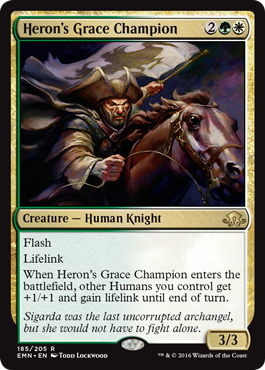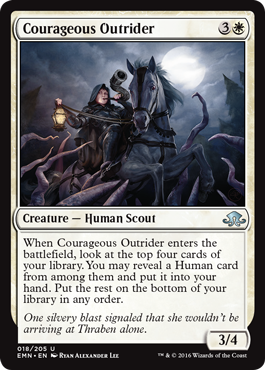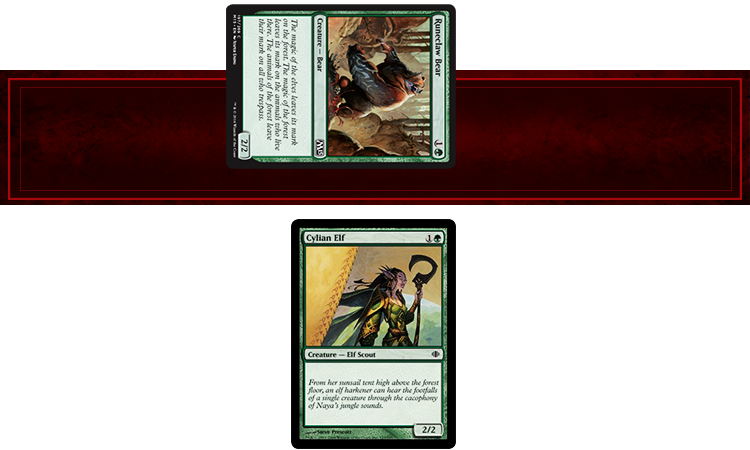The Trouble with Tribals
Grab your favorite creature type—it's time to talk about tribal decks!
If you aren't familiar with the term "tribal" in the Magic lexicon, it essentially refers to creature types—or in our case, decks built around a specific creature type. For example, you might have a Goblin tribal deck or a Beast tribal deck. And on Innistrad, we tend to shine a bright light on five specific tribes: Humans, Spirits, Zombies, Vampires, and (Were)Wolves!
But how do you build a tribal deck? What makes it work? What are some tips for playing one? Let's take a look today! (And perhaps we'll find some Eldritch Moon preview cards along the way to boot.)
Decks built around creature types have been around since the dawn of Magic, when good ol' Richard Garfield printed cards like
If you want to build and play a tribal deck, there are a few things you should keep in mind.
Make Sure Enough Support Exists
So you have an idea for a tribal deck. Great! The first thing you should do before starting to build it is make sure that the tribe actually has the support to make it work—or, if it doesn't, know how you plan to maximize that support.
For example, let's say you want to build an Archer tribal deck in Modern. You start with
To make matters more complicated, it's not like Magic has a storied history of extremely strong Archers to play with. Suddenly, you have one lord and a bunch of middling creatures—which isn't going to be as effective as you might have hoped.
Generally, the way tribal decks work (with a few exceptions I'll mention later) is that they want to play a lot of creatures and then cards that make those creatures' types matter. The weaker the individual creatures are, the better the tribal rewards need to be to get you to play them. The opposite is also true: the better the individual creatures are, the weaker the tribal rewards need to be to convince you to play a lot of them. (And, of course, the sweet spot is when you have very strong tribal rewards and very strong individual creatures!)
Sometimes you might have to play a couple creatures that are just below the bar of normal playability, but you certainly don't want to fill your deck up with those.
And while you can fill the gaps in your Archer tribal deck with cards like
To look at something that's been a tad more effective than Archers, let's switch our viewpoint to Humans in the current Standard format with Shadows over Innistrad.
Humans have been incredibly successful in the current Standard format. There are a number of reasons why (some of which I'll cover later), but at the core is this: they have plenty of individually powerful cards, along with powerful tribal bonuses. Many of the Humans are good to play on their own,
Then look at the tribal support.
Heron's Grace Champion is the same exact way.
Oh, what's Heron's Grace Champion? Well, I suppose I should show it to you so you know exactly what I'm talking about.
Prepare yourself to face the Heron's Grace:

As a four-mana 3/3 flash creature with lifelink, it certainly isn't a shabby card in its own right. If you topdeck it late, you're not going to be sad.
But with a board full of Humans? It's just crazy!
Not only does it pump up your entire team, but it gives all of them lifelink so you can recoup any hits you might have taken.
As a fine card on its own and one that's incredibly strong with other Humans on the battlefield, this is a great example of what you're looking to play in these kinds of decks. I expect to see plenty of Heron's Grace Champions in the future of Standard.
Maximize Your Tribe
Generally speaking (and I'll get into a couple exceptions later), if you're going to be playing a ton of cards to make your tribe work, you should make sure you maximize the strong parts of your deck: the tribal parts!
For example, one of the most common errors I see when building a tribal deck is to simply not have enough creatures! If you're playing an aggressive or midrange tribal deck and you're only including sixteen creatures, you have to ask yourself: "Is it even worth playing all of these tribal cards in the first place?" If, for example, you only have enough creatures to have a couple in play at any given time, you're not maximizing your tribe's abilities.
I would want a large chunk of my tribal deck to be creatures of my tribe, generally at minimum 22 cards, and ideally 25 to 30. You will also want these to have a good curve, favoring cheaper creatures over pricier ones so you can put more onto the board quickly.
Yes, this often means you are playing fewer removal spells and tricks than normal—and that's okay! The premise of playing tribal is that the rest of your cards will be made far more powerful because of synergy. (Additionally, some of these effects are often built into tribal rewards on creatures for the tribe, such as Heron's Grace Champion being a combat trick in addition to also being a creature.)
Additionally, there are cards that want your deck to have a higher overall count of a creature type to make sure they work more often. For example, take the classic
Or, to put things in a more modern context, let's take a look at another brand-new Eldritch Moon card, Courageous Outrider!

Though, unlike with the Ringleader, you only pick up one of the revealed cards, it's still crucial you don't miss. You want to build your deck in such a way that you always reveal a Human when you cast this card, and ideally, so that you have choices and can take a good one for the situation.
It's not enough for you to just make sure you have enough Humans on the battlefield—you need to have enough in your deck for your Courageous Outriders to consistently hit! (And keep in mind that instants, sorceries, and enchantments that create tokens don't count for this.)
If you're going to go tribal, make sure you're taking full advantage of the tribal cards you're working to play.
The Art of Deviation
Generally, in a tribal deck, you want to avoid playing creatures that aren't of your tribe if possible. They don't receive the bonuses that your other cards provide to creatures of your tribe.
However, there are exceptions.
I'll always remember the Black-Green Elves deck that Charles Gindy used to win Pro Tour Hollywood in 2008. A deck full of Elves—and smack-dab in the middle of it? Four copies of
Now,
In general, I would look at these two factors when looking to include cards not of your tribe's creature type:
- Is this creature so strong that it, on its own, is generally stronger than my tribal creatures when they are receiving bonuses and/or empowering my other cards? (As was the case with
Tarmogoyf there.) - If I count this as a noncreature spell, will I still have enough creatures for the tribal cards in my deck to function?
The thrust behind the second point is to make sure that you aren't kicking out a bunch of tribal cards from your deck to fit in cards like these, to the point where you'd be better off not playing tribal anymore. It's just one step from adding
Play to Your Strengths
Okay, so you have a tribal deck and you've sat down to a game. What should you keep in mind while playing it?
Well, the key with tribal decks is that they derive bonuses from having a lot of creatures of their tribe. You want to make sure you're playing to maximize that.
Let's create a very simplified situation as an example of what I mean.
You are playing tribal Elves, and your opponent is playing a green midrange deck. Your opponent plays a turn-two

If you're playing tribal, generally you should not block here.
Why? Well, your deck derives an advantage from building up a board over time. And even though your creatures look identical, yours actually has the quite relevant "ability" of being an Elf! If you untap and play an
Now, of course, this situation is very much boiled down to the core essence. The right play is going to depend on the matchup (if they're a very fast deck it could be right to block), your hand (if your next play is a
On the flip side, since your deck is so heavily creatures, that means you have fewer noncreature cards than normal and potentially less resilience to effects like board sweepers. This means you should carefully deploy any removal spells in your hand on appropriate targets, since you are less likely to draw more, and you really need to make sure to play around your opponent's board clears. (All depending on your exact deck, of course.)
Keep in mind the fact that you're playing a tribal deck, and adjust your play to optimize for that.
Big Exceptions
Remember earlier when I said I was going to cover the exceptions later on? Well, we've hit that point!
Most of the aforementioned strategy deals with smaller tribes, full of cheap creatures. That's the vast majority of tribally supported creature types in Magic, and it's true of the primary five that are in Shadows over Innistrad block.
But while it does hit the majority, it's not true of all tribes.
For example, take Dragons.
Dragons plays very differently. It's a "big tribe." Often, a single one of these cards already has a tremendous impact on the game, so you don't need to fill your deck with tons and tons of them. A 25-Dragon deck is probably quite excessive. (And prone to not casting any spells for a while.)
What you want to do instead is first, figure out the core that's going to enable your more expensive cards to work here. For example, a ramp or control core, both of which are good at getting to a spot in the game where you can cast your pricy spells.
Then, you want to include just enough tribal cards of your type so that they can synergize without overcrowding. Since they will each have a large individual impact, you don't need to necessarily cast a lot of them—but the second one tends to seal the deal. Unlike the cheaper tribes, which need plenty of cards of that type to function, simply casting Silumgar into Atarka will tend to put the game right into your grip.
Additionally, in the case of Dragons, there are also cheaper spells that reward you for playing Dragons in your deck.
These are some things the Dragons deck gets access to as ways to help make sure you get to cast your late game Dragons—and to encourage you to have enough Dragons. Notice, though, that these are still just asking for you to have a single Dragon to reveal—you don't need to go overboard to make these work!
While there haven't been that many big tribes so far, they should be treated differently, with all of their cards and support contextually in mind.
Tribal Knowledge
No matter whether you want to build for Goblins, Treefolk, Zombies, or, yes, even Archers, hopefully you found some tips to ease you along the deck-building process! No matter which tribe you love (go Wizards!), tribal decks are a blast to play.
And those new Humans? Yeah, I'd expect to see them around. Here's my fresh take on Bant Humans:
With Heron's Grace Champion around, leaving up four mana is scarier than ever, since it could be that or
Get out there and start playing to discover for yourself!
No matter what your take on tribal, I'd love to hear from you. If you have any thoughts, questions, gameplay situations, future column topic suggestions, or otherwise, please fire them off my way!
Where to? Well, you can always reach me on Twitter or Tumblr. That's the best way to get to me right away, but if email is better for you, you can also write to me at beyondbasicsmagic@gmail.com.
I'll be back again next week. Until then, enjoy Eldritch Moon—and may your tribal decks come together well.
Talk with you again soon,
Gavin

